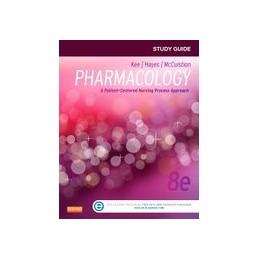- Reduced price

Order to parcel locker

easy pay


 Delivery policy
Delivery policy
Choose Paczkomat Inpost, Orlen Paczka, DHL, DPD or Poczta Polska. Click for more details
 Security policy
Security policy
Pay with a quick bank transfer, payment card or cash on delivery. Click for more details
 Return policy
Return policy
If you are a consumer, you can return the goods within 14 days. Click for more details
Data sheet
Unit I: Introduction to Pharmacology 1. Drug Action: Pharmaceutic, Pharmacokinetic, and Pharmacodynamic Phases 2. The Drug Approval Process 3. Cultural and Pharmacogenetic Considerations 4. Drug Interactions and Over-the-Counter Drugs 5. Drugs of Abuse 6. Herbal Therapies 7. Pediatric Pharmacology 8. Geriatric Pharmacology 9. Collaboration in Community Settings NEW QSEN focus! 10. The Role of the Nurse in Drug Research Unit II: A Nurses Perspective of Pharmacology 11. The Nursing Process in Patient-Centered Pharmacotherapy NEW QSEN focus! 12. Safety and Quality in Pharmacotherapy NEW QSEN focus! 13. Medication Administration Unit III: Drug Calculations 14. Medications and Calculations Section 14A: Systems of Measurement with Conversion Section 14B: Methods for Calculation Section 14C: Calculations of Oral Dosages Section 14D: Calculations of Injectable Dosages Section 14E: Calculations of Intravenous Fluids Section 14F: Pediatric Drug Calculations Unit IV: Nutrition and Electrolytes 15. Vitamin and Mineral Replacement 16. Fluid and Electrolyte Replacement 17. Nutritional Support Unit V: Autonomic Nervous System Agents 18. Adrenergic Agonists and Adrenergic Blockers 19. Cholinergic Agonists and Anticholinergics Unit VI: Neurologic and Neuromuscular Agents 20. Central Nervous System Stimulants 21. Central Nervous System Depressants 22. Anticonvulsants 23. Drugs for Neurological Disorders: Parkinsonism and Alzheimers Disease 24. Drugs for Neuromuscular Disorders: Myasthenia Gravis, Multiple Sclerosis, and Muscle Spasms Unit VII: Pain and Inflammation Management Agents 25. Antiinflammatory Drugs 26. Nonopioid and Opioid Analgesics Unit VIII: Psychiatric Agents 27. Antipsychotics and Anxiolytics 28. Antidepressants and Mood Stabilizers Unit IX: Antibacterial and Antiinfective Agents 29. Penicillins and Cephalosporins 30. Macrolides, Tetracyclines, Aminoglycosides, and Fluoroquinolones 31. Sulfonamides Unit X: Additional Antiinfective Agents 32. Antituberculars, Antifungals, Peptides, and Metronidazole 33. Antivirals, Antimalarials, and Anthelmintics 34. Drugs for Urinary Tract Disorders Unit XI: Immunologic Agents 35. HIV- and AIDS-Related Drugs 36. Vaccines Unit XII: Antineoplastic Agents 37. Anticancer Drugs 38. Targeted Therapies to Treat Cancer 39. Biologic Response Modifiers Unit XIII: Respiratory Agents 40. Drugs for Upper Respiratory Disorders 41. Drugs for Lower Respiratory Disorders Unit XIV: Cardiovascular Agents 42. Cardiac Glycosides, Antianginals, and Antidysrhythmics 43. Diuretics 44. Antihypertensives 45. Anticoagulants, Antiplatelets, and Thrombolytics 46. Antihyperlipidemics and Peripheral Vasodilators Unit XV: Gastrointestinal Agents 47. Drugs for Gastrointestinal Tract Disorders 48. Antiulcer Drugs Unit XVI: Eye, Ear, and Skin Agents 49. Drugs for Eye and Ear Disorders 50. Drugs for Dermatologic Disorders Unit XVII: Endocrine Agents 51. Endocrine Drugs: Drugs for Pituitary, Thyroid, Parathyroid, and Adrenal Disorders 52. Antidiabetics Unit XVIII: Reproductive and Gender-Related Agents 53. Female Reproductive Cycle I: Pregnancy and Preterm Labor Drugs 54. Female Reproductive Cycle II: Labor, Delivery, and Preterm Neonatal Drugs 55. Postpartum and Newborn Drugs 56. Drugs for Womens Reproductive Health and Menopause 57. Drugs for Mens Health and Reproductive Disorders 58. Drugs for Disorders in Womens Health, Infertility, and Sexually Transmitted Infections Unit XIX: Emergency Agents 59. Adult and Pediatric Emergency Drugs
